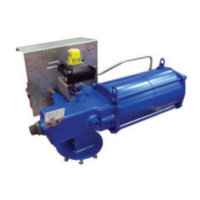9
1
1
2
3
2
2
P
3
4
5
1
P
RPS SPRING RETURN PNEUMATIC ACTUATOR
INSTALLATION, OPERATION AND MAINTENANCE MANUAL
On-Off service: three way control valve
The diagram shows the simplest On-Off
control. The control valve (2) has two positions.
In one position the gas supply pressure is
connected to the cylinder chamber, and the
actuator performs the “pneumatic” operation.
In the other position the cylinder is connected
to the exhaust and the actuator moves under
the operation of the spring.
The control valve can have many types of
actuating devices (solenoid, manual control,
pneumatic pilot, spring, etc.).
The spring return control valves allow
“failsafe” operation.
On-Off service: quick spring operation
When fast action is required under spring
operation, a quick exhaust valve (3) is installed
in the cylinder directly port to exhaust the gas
from the cylinder directly to the atmosphere.
When the control valve (2) opens to the
atmosphere a differential pressure is created
across the quick exhaust valve (3) causing it
to open. The resultant high flow capacity from
cylinder to atmosphere allows quick spring
operation of the actuator.
Modulating service
When modulating control is required as a
function of a pneumatic or electric control
signal, a positioner (5) is used, which controls
the supply to the actuator cylinder to keep the
valve in the required angular position.
The positioner has a mechanical linkage to the
actuator, for a feedback of the valve position.
Pressurized air
Atmospheric pressure air
Manual
control
Pneumatic
pilot control
Pneumatic
positioner
Pneumatic
control signal
Electric
controlsignal
Electropneumatic
positioner
Pressurized air
Atmospheric pressure air
Pressurized air (supply)
Reduced pressure air
Solenoid
control
FIGURE 8A
FIGURE 8B
FIGURE 8C

